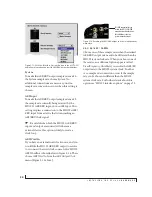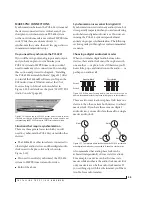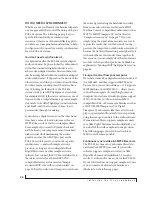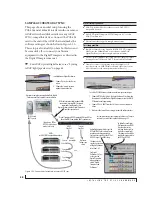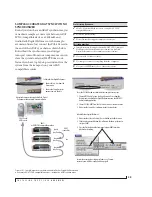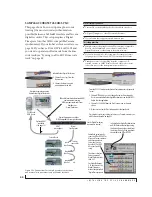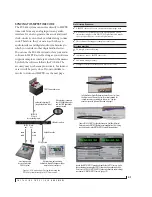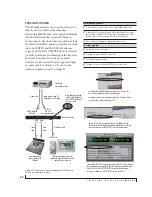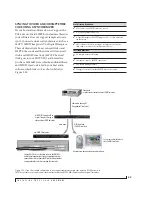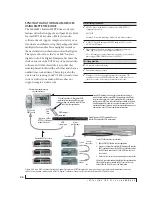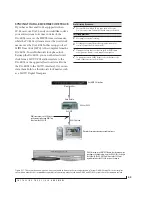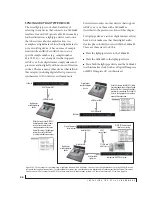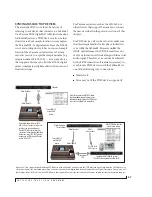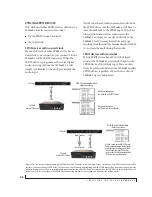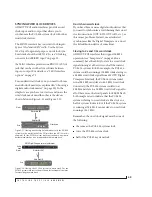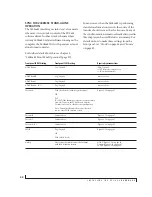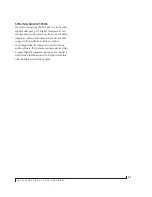
I N S T A L L I N G T H E P C I - 4 2 4 H A R D W A R E
36
DO YOU NEED A SYNCHRONIZER?
Whether or not you’ll need a synchronizer depends
on your gear and what you will be doing with your
PCI-424 system. The following pages give you
specific information about common sync
scenarios. At least one of them will likely apply to
you. Here are some general considerations to help
you figure out if you need (or want) a synchronizer
for you PCI-424 system.
You don’t need a synchronizer if...
As explained earlier, the PCI-424 system’s digital
audio clock must be phase-locked (synchronized)
with other connected digital audio devices to
achieve clean digital transfers between them. Can
this be accomplished without an additional digital
audio synchronizer? It depends on the nature of the
other devices, and what you want to do with them.
You don’t need a synchronizer if the device has a
way of locking itself directly to the PCI-424
system’s clock (via ADAT lightpipe or word clock,
for example), AND if the device carries no sense of
location in time. A digital mixer is a good example:
it can slave to its ADAT lightpipe connection from
a 2408mk3, and it has no sense of time; it just
passes audio through for mixing.
A stand-alone digital recorder, on the other hand,
does have a sense of location in time, either via
SMPTE time code or via its own sample address.
For example, if you want to fly tracks back and
forth between your computer and an Alesis hard
disk recorder while maintaining the audio’s
position in time, the ADAT Sync port on the
PCI-424 card lets you do so without a separate
synchronizer — and with sample-accurate
precision, as long as you’re using AudioDesk,
Digital Performer, or other sample-accurate
software. Just connect the PCI-424 card directly to
the Alesis recorder (or other ADAT SYNC-
compatible device) as discussed in “Sample-
accurate ADAT sync with no synchronizer” on
page 39. But if you also want transport control over
the entire rig (including the hard disk recorder)
from your audio software, you’ll need a MIDI
Machine Control-compatible synchronizer such as
MOTU’s MIDI Timepiece AV, as discussed in
“Sample-accurate sync” on page 37. If you are
simply using the stand-alone recorder as a way to
capture live tracks that you then transfer in one
pass into the computer, no synchronizer is required
because the tracks will remain in perfect phase lock
with each other as you transfer them together. In
this scenario, you can simply slave the stand-alone
recorder to the optical output from a 2408mk3 as
explained in “Syncing ADAT ‘lightpipe’ devices” on
page 46.
Transport control from your computer
If you have stand-alone digital recorders connected
to a 2408mk3, and they support ADAT Sync or
Tascam Sync, your audio software — if it supports
MIDI Machine Control (MMC) — allows you to
control the transports of everything from your
computer. Most advanced audio programs support
MMC. To do this, you’ll also need an MMC-
compatible ADAT or Tascam synchronizer, such as
a MOTU MIDI Timepiece AV or Digital
Timepiece. Synchronizers like these allow you to
play, stop, rewind and locate all of your tape decks
using the transport controls in the audio software.
If your audio software supports sample-accurate
sync (like Digital Performer and AudioDesk), you
can do all of this with sample-accurate precision.
The following pages show you how to achieve
MMC control, where possible.
Continuous sync to video & SMPTE time code
The PCI-424 system can synchronize directly to
video and/or SMPTE time code. If your audio
software supports sample-accurate sync (like
Digital Performer and AudioDesk), it can also
resolve to video and/or time code via the PCI-424.
If your software does not support sample-accurate
sync, you need a dedicated synchronizer, as
illustrated on the following pages.
Summary of Contents for PCI-424
Page 35: ...6 ...
Page 43: ...14 ...
Page 45: ...16 ...
Page 53: ...P A C K I N G L I S T A N D P C S Y S T E M R E Q U I R E M E N T S 24 ...
Page 83: ...I N S T A L L I N G T H E P C I 4 2 4 H A R D W A R E 54 ...
Page 103: ...M O T U P C I A U D I O C O N S O L E 74 ...
Page 111: ...C U B A S E N U E N D O A N D O T H E R A S I O S O F T W A R E 82 ...
Page 115: ...S O N A R A N D O T H E R W D M S O F T W A R E 86 ...
Page 119: ...E X P A N D I N G Y O U R P C I 4 2 4 S Y S T E M 90 ...
Page 125: ...R E D U C I N G M O N I T O R I N G L A T E N C Y 96 ...
Page 131: ...C U E M I X C O N S O L E 102 ...
Page 148: ...6 ...
Page 156: ...14 ...
Page 158: ...16 ...
Page 166: ...P A C K I N G L I S T A N D M A C I N T O S H S Y S T E M R E Q U I R E M E N T S 24 ...
Page 194: ...I N S T A L L I N G T H E P C I 4 2 4 H A R D W A R E 52 ...
Page 230: ...A U D I O D E S K 88 ...
Page 246: ...E X P A N D I N G Y O U R P C I 4 2 4 S Y S T E M 104 ...
Page 258: ...C U E M I X C O N S O L E 116 ...













